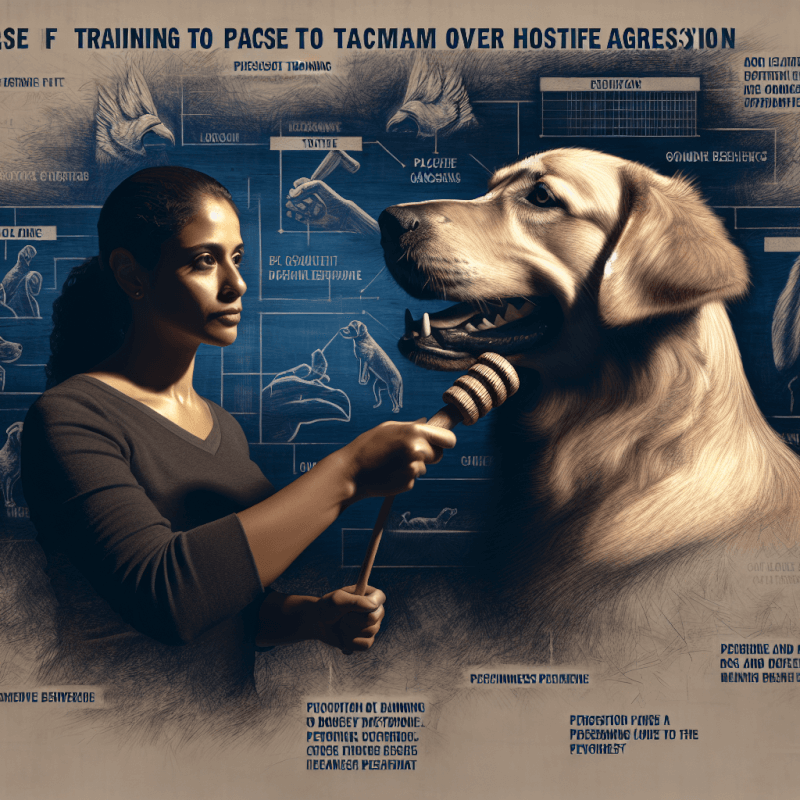If you’ve ever found yourself struggling with your furry companion’s aggressive behavior, worry no more! In this article, you’ll discover effective techniques to put an end to your dog’s aggressive tendencies. From understanding the root causes of aggression to implementing positive reinforcement techniques, you’ll learn how to create a safe and harmonious environment for both you and your beloved pooch. So, say goodbye to those challenging moments and get ready to embark on a journey of transformation with your four-legged friend!
Understanding Aggressive Behavior in Dogs
Aggressive behavior in dogs can be concerning and challenging for dog owners to handle. It is important to understand the different types of aggressive behavior and the common triggers that can lead to aggression. By recognizing the signs of aggression early on, you can take appropriate measures to address and manage this behavior effectively.
Ready for Cat Trivia?
Test your knowledge about cats!

Types of aggressive behavior
There are various types of aggressive behavior that dogs may exhibit. These include territorial aggression, fear aggression, possessive aggression, protective aggression, social aggression, and predatory aggression. Each type of aggression may manifest differently, and it is crucial to identify which type your dog is displaying in order to tackle it appropriately.
Common triggers for aggression
Aggression in dogs can be triggered by a variety of factors. Some common triggers include fear, anxiety, frustration, lack of socialization, resource guarding, illness or pain, and territorial instincts. Understanding what triggers your dog’s aggression can help you avoid or manage those situations more effectively.
Recognizing signs of aggression
It is essential to be able to recognize the signs of aggression in dogs. These can include growling, biting, snapping, lunging, raised fur or hackles, a stiff body posture, and intense staring. Additionally, dogs may display other signs of anxiety or fear, such as trembling, pacing, panting, and avoiding eye contact. By being vigilant and observant of these signs, you can intervene early and prevent any potential aggressive incidents.
Establishing Leadership and Boundaries
To address aggressive behavior in dogs, it is crucial to establish yourself as a strong leader while providing clear boundaries for your dog to follow. This helps create a sense of security and stability for your dog, reducing the likelihood of aggressive outbursts.
Building trust and respect
Building trust and respect with your dog is the foundation for effective leadership. Spend quality time bonding with your dog and engage in activities that strengthen your bond, such as obedience training or interactive play. Consistency, patience, and positive reinforcement are key elements in establishing trust and respect between you and your furry friend.
Establishing a consistent routine
Dogs thrive on routine, so it is important to establish consistent daily routines for feeding, exercise, training, and rest. By providing a structured environment, you are setting clear expectations and boundaries for your dog to understand and follow. This sense of predictability can help reduce stress and prevent aggressive behavior.
Using positive reinforcement
Positive reinforcement is a powerful tool in training and managing aggressive behavior in dogs. Rewarding desirable behavior with treats, praise, and playtime reinforces the idea that good behavior is valued and encourages your dog to repeat it. This positive approach helps build a bond of trust with your dog and reinforces positive habits while minimizing the likelihood of aggressive behavior.

Socializing Your Dog
Socialization is a critical aspect of every dog’s development. It helps dogs become more comfortable and confident in different environments, reducing the likelihood of aggression due to fear or anxiety.
Importance of socialization
Socialization is crucial for dogs to learn appropriate behavior and how to interact with other dogs and people. Early and ongoing exposure to various stimuli, such as different environments, sounds, smells, and experiences, can help your dog become well-rounded and less prone to aggressive behavior triggered by unfamiliar situations.
Gradual exposure to different environments
When socializing your dog, it is important to introduce them gradually to different environments and scenarios. Begin in controlled and familiar settings, gradually increasing the level of exposure to new places, people, and animals. This gradual approach allows your dog to build confidence and positive associations with new experiences, reducing the chances of fear or aggression.
Positive experiences with other dogs and people
Organizing playdates or attending group training classes can provide positive social experiences for your dog. Exposing your dog to well-behaved and friendly dogs, as well as different people of various ages and backgrounds, helps them learn appropriate social skills. Positive interactions and playtime with others can contribute to a well-socialized and non-aggressive dog.
Utilizing Basic Obedience Training
Basic obedience training is essential for all dogs, regardless of their aggression issues. Teaching fundamental commands and using reward-based training methods can be highly effective in managing and curbing aggressive behavior.
Teaching commands like ‘sit’ and ‘stay’
Teaching basic commands such as “sit,” “stay,” and “leave it” can provide your dog with structure, discipline, and self-control. These commands establish clear guidelines for your dog’s behavior and can help redirect their attention during potentially challenging situations. Consistently practicing these commands reinforces your role as the leader and improves obedience, reducing the risk of aggression.
Using reward-based training methods
Reward-based training methods, such as positive reinforcement, treat rewards, and praise, are highly effective in modifying a dog’s behavior. Instead of focusing on punishment or dominance, rewarding your dog for good behavior encourages them to repeat those actions. This positive approach increases their trust in you and promotes a cooperative and non-aggressive attitude.
Consistency and repetition
Consistency is vital in obedience training to prevent and manage aggression. Regular training sessions, using the same commands and rewards, help reinforce desired behavior and establish clear boundaries. Consistent training promotes a sense of structure and helps your dog understand what is expected of them, ultimately reducing the likelihood of aggressive behaviors.

Addressing Fear and Anxiety
Fear and anxiety are common underlying causes of aggression in dogs. Addressing these emotions is crucial to helping your dog feel more secure and less likely to exhibit aggressive behavior.
Identifying underlying causes of fear
Identifying the root causes of your dog’s fear and anxiety is essential in addressing their aggressive behavior. These causes can include past traumatic experiences, lack of socialization, specific phobias, or medical conditions. By understanding the triggers for their fear, you can work on desensitization and counter-conditioning techniques to help them overcome their anxieties.
Counter-conditioning and desensitization
Counter-conditioning involves changing your dog’s emotional response to specific triggers. By gradually introducing the trigger in a controlled and positive way while associating it with something enjoyable, such as treats or play, you can help your dog create new positive associations. Desensitization involves slowly exposing your dog to the trigger at a distance or intensity that does not elicit an aggressive response. Over time, these techniques can help your dog become more comfortable and less fearful, reducing their aggression.
Seeking professional help if needed
If your dog’s aggression persists or worsens despite your efforts, it is crucial to seek professional help. A qualified dog behaviorist or trainer can assess your dog’s behavior, provide personalized strategies, and guide you on how to address and manage their aggression effectively. Professional intervention can make a significant difference in helping your dog overcome their aggression and improve their overall well-being.
Introducing Desensitization Techniques
Desensitization techniques can be effective in managing and reducing aggression triggered by specific stimuli or situations. By gradually exposing your dog to their triggers in a controlled and positive way, you can help them build tolerance and reduce their aggressive responses.
Gradual exposure to triggers
Start by identifying the specific triggers that elicit aggression in your dog. It could be other dogs, strangers, loud noises, or certain objects. Begin exposing your dog to these triggers from a distance or at a level where they remain calm and relaxed. Over time, slowly decrease the distance or intensity of the trigger, always ensuring your dog feels safe and comfortable. This gradual exposure helps your dog build confidence and reduces their aggressive reactions.
Rewarding calm behavior
During the desensitization process, it is important to reward your dog for displaying calm behavior in the presence of their triggers. This could involve offering treats, praise, or playtime whenever your dog remains calm and does not exhibit signs of aggression. By positively reinforcing their calm behavior, you are encouraging them to associate their triggers with positive experiences, gradually diminishing their aggressive responses.
Creating positive associations
Creating positive associations with triggers is key to minimizing aggressive behavior. For example, if your dog shows aggression towards other dogs, you can gradually introduce controlled interactions with calm and well-behaved dogs, rewarding your dog for friendly behavior. Over time, your dog will learn that encountering other dogs results in positive experiences, reducing their aggressive tendencies.

Managing Aggressive Situations
While working on minimizing aggression in dogs, it is essential to manage and avoid situations that may trigger aggressive behaviors. By using proper handling techniques and implementing safety measures, you can ensure the well-being of both your dog and others.
Avoiding confrontational situations
Prevention is key when it comes to managing aggression. Avoid exposing your dog to situations that are likely to trigger aggressive responses, such as overcrowded places, confrontational dogs, or intense stimuli. By proactively managing their environment, you can reduce the chances of aggressive incidents occurring.
Using proper handling techniques
When handling a dog prone to aggression, it is crucial to use proper techniques that prioritize everyone’s safety. This may involve using a secure leash and harness, maintaining a firm grip, and employing gentle yet assertive control. Avoid physically punishing or intimidating your dog, as it can escalate their aggression and damage the trust between you.
Implementing safety measures
In situations where aggression cannot be avoided, implement safety measures to protect your dog and others. This may include using muzzles or basket-style muzzles that allow your dog to breathe and pant comfortably. Additionally, familiarize yourself with emergency procedures and have a plan in place in case an aggressive incident occurs.
Dealing with Resource Guarding
Resource guarding refers to the aggressive behavior exhibited by dogs when they perceive a threat to their valued possessions, such as food, toys, or personal spaces. Addressing this behavior is crucial to prevent potential conflicts and maintain a harmonious environment.
Understanding the instinct behind guarding
Resource guarding is a natural instinct for dogs, rooted in their survival instincts and the need to protect valuable resources. It is essential to understand that resource guarding does not necessarily make your dog aggressive, but it does create a potential risk for conflict. By acknowledging this instinct, you can approach the behavior with understanding and work towards modification.
Teaching the ‘drop it’ command
To address resource guarding, teaching your dog the “drop it” command can be highly effective. This command helps your dog release their grip on an item when prompted, reducing the likelihood of aggressive behavior when someone tries to take an item away. By consistently practicing this command and rewarding compliance, you can improve your dog’s willingness to share and reduce guarding behavior.
Slowly desensitizing the dog to sharing
Gradually desensitizing your dog to sharing their valued resources can help reduce resource guarding. Start by practicing exchanging a low-value item for a high-value treat. Gradually increase the value of the item being exchanged while ensuring a positive and rewarding experience for your dog. This process helps your dog associate sharing with pleasant experiences, minimizing guarding behavior.

Seeking Professional Help
Addressing aggressive behavior in dogs can be a complex and challenging task. If your efforts do not yield significant improvements or if the aggression is escalating, it is crucial to seek professional help from a qualified dog behaviorist or trainer.
Recognizing when professional intervention is necessary
Professional intervention may be necessary if your dog’s aggression persists despite your efforts, or if it poses a serious threat to safety. Signs that it is time to consult a professional include excessively intense aggression, uncontrollable behavior, aggressive behavior towards family members or children, or aggression triggered by specific situations that cannot be avoided.
Finding a qualified dog behaviorist or trainer
When seeking professional help, it is important to find a qualified and experienced dog behaviorist or trainer. Look for professionals who have credentials, positive reviews, and a track record of successfully addressing aggressive behavior in dogs. Consultation with a professional can provide personalized guidance and specialized techniques for managing and modifying aggression.
Working in collaboration with the professional
Collaborating with a professional is crucial in achieving long-term success in managing aggression. Follow their guidance, be consistent with implementing their recommendations, and communicate openly about any challenges or improvements. Working together as a team will optimize the outcome and give your dog the best chance of overcoming their aggressive behavior.
Creating a Supportive Environment
Creating a supportive environment for your dog is essential for their overall well-being and helps prevent aggression. By ensuring consistency among all family members, providing mental and physical stimulation, and creating a loving and structured home, you can help your dog lead a happy and non-aggressive life.
Consistency among all family members
Consistency is vital in maintaining a supportive environment for your dog. Ensure that all family members follow the same rules, boundaries, and training techniques. This consistency helps your dog understand what is expected of them, minimizing confusion and potential triggers for aggression.
Providing mental and physical stimulation
Dogs need both mental and physical stimulation to stay happy and content. Engage in regular playtime, walks, and exercise sessions to keep your dog physically active and help release any pent-up energy. Additionally, provide mental stimulation through interactive toys, puzzle games, and training exercises to keep your dog mentally engaged, preventing boredom and reducing the likelihood of aggressive behavior.
Ensuring a loving and structured home
A loving and structured home environment helps your dog feel secure and provides them with a sense of belonging. Offer plenty of affection, praise, and positive reinforcement to strengthen the bond between you and your dog. Additionally, set clear rules and boundaries, consistently reinforce them, and avoid any situations that may cause stress or fear. This combination of love and structure fosters a safe and supportive home for your dog, reducing the likelihood of aggressive behavior.
Addressing aggressive behavior in dogs requires patience, understanding, and consistent effort. By following these guidelines and seeking professional help when necessary, you can successfully manage and reduce aggression in your dog, creating a harmonious and safe environment for both your furry friend and your family.



